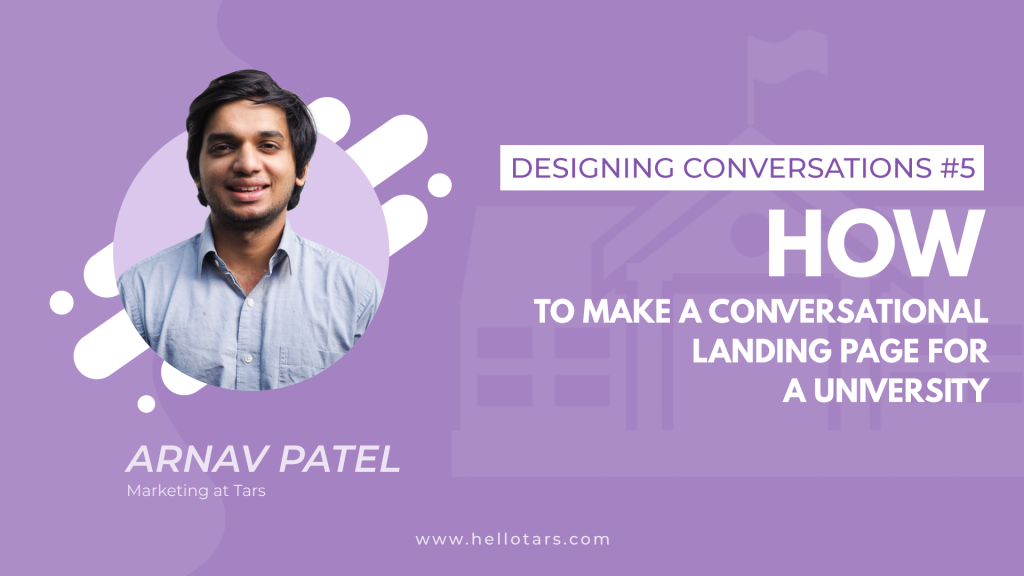In a competitive higher education marketing landscape, universities are finding it increasingly difficult to capture students’ attention and expand the number of people entering the admissions funnel. This issue is more than just an inconvenience, it is a real monetary burden. Digital ads are a key lead generation channel for many universities, and their effectiveness is wholly dependent on capturing user attention. As attention diminishes, so does the conversion rate on these digital ads, and as conversion rates drop, cost per lead skyrockets. At the root cause of this issue is poor landing page design. Traditional CRO is outdated and fails to meet the needs of both students and universities. Forms, text blocks, and stock images are all common elements of traditional landing pages which no one likes interacting with. Conversational Landing Pages are a potential solution. They reimagine the traditional landing page as a conversation with the underlying design philosophy that less is more. In the process, they increase information retention and capture user attention. This in turn results in a 2-3x increase in conversion rate and a corresponding reduction in cost per lead. Of course, seeing any of these benefits is wholly dependent on implementation. If you build a poor conversational landing page it will result in poor results. This guide prevents that from happening. Watch the video below to see exactly how you can build your own university conversational landing page.
Check out the Drexel conversational landing page:
https://drexel.hellotars.com/conv/r1Gtqk/And the Drexel traditional landing page:
https://duo.online.drexel.edu/computer-science-group/
Landing Page Assessment
As always, I like to begin the creation process with a landing page assessment. I looked up online computer science program on google, got four ads (with a CPC of close to $20) and clicked on the second link from Drexel University. Here’s the landing page that I got.
The landing page isn’t awful in that it is usable, but it isn’t great either. It doesn’t have many visual elements on it. Past the graphics beneath the first fold and the binary in the background of the first fold there aren’t many visual elements on the page. This is a problem because people think visually.
Relatedly, the page is highly dependent on disparate, verbose blocks of text to convey information, and human beings hate reading.
Worst of all, the page uses a form for lead capture, and if there is one thing that I know after working in CRO it’s that people hate filling out forms.
Putting these three issues together, it starts to make sense as to why landing pages like the one one above yield abysmally low conversion rates.
Building a Conversational Landing Page
Broadly speaking there are three stages in the conversational landing page creation process: hook, lead generation, branding. Here’s a breakdown of each for the Drexel landing page:
Hook
The hook is a set of three messages and a user input field a prospect sees when they click onto your conversational landing page. In many ways it serves the same purpose as the first fold of a traditional landing page. It establishes legitimacy, captures attention and provides a call to action for those who want to express interest in the service or product being offered. In fact these three elements form the anatomy of the the hook.
While creating such a hook, I like to keep 5 best practices in mind:
- Use a logo in the first message- When prospects land on a page they expect to see a uniform brand, and a big part of this is seeing the proper logo. Logos tell prospects they are on the right page and they lend the page a base level of legitimacy that is required to make those paid clicks convert into information requests. It doesn’t take much time and most universities have great looking logos so there’s no harm in showing it off right at the start.
- Keep the Value Prop message short and singular- Your prospects might be future leaders of industry but they are still human, and human beings, especially millenials hate reading. This is why I encourage having a single value proposition message that is short.
- Make your ask uncontroversial- Across industries, prospects don’t like sharing personal information until they feel a sense of investment in a service. In practice this means that you can’t start asking prospects for their lead info as soon as they land on your page. It feels abrupt and it causes people to drop.
- Use a button for user input- This last point is related to the previous one. When you have an uncontroversial ask it should be easy to respond with a single tap button. Such a user input has a significant advantage over others: it takes less effort to use it. Think about it this way, if a page asked me for my first name, that would take me 6 taps to send (5 for my name and 1 to hit send). Each tap is an opportunity for dropping from the page. A single tap button reduces this opportunity considerably.
Lead Generation Experience
Chat-based lead capture is very different from form-based lead capture. Forms are impersonal and as a result theey don’t require much thought to create. You can just say “Name:” and have a blank field to capture a prospect’s name and that would be acceptable. In a chat on the other hand, you are bound by the rules of human customer service. This means that you have to ask for details in a way that feels more human (i.e. in full sentences). It takes more effort, but this personality is what prospects appreciate and what gives you the jump in conversion rate. But, to see these benefits you need to execute well, and there are two best practices to keep in mind when trying to achieve this:
- Make your questions sound human- A good rule of thumb is phrase messages the way you would if you were the bot. This is a sure-shot way to make your bot sound human.
- Acknowledge User Input- If a user tells you their name say “Nice to meet you [insert name],” before you ask for the next detail. If they tap the Get More Info Button, say “Awesome! I need a few details to get you set up” and then start asking for info. This is more corteous, and it’s just basic customer service.
- Ask for email and phone number at the end of the conversation- This is a best practice I learned from one of our customers who ran an AB test. They found that asking for contact info at the start of a conversation always yields a lower conversion rate, so I recommend tacking it on at the end of the conversation as an incedental detail to the rest of the process.
Design
As I mentioned earlier, when I was talking about the hook, branding is important. It makes your page feel more legitimate and it improves the overall user experience of the leadgen experience. In a chat interface, the best way to achieve this is to match the message bubble colors with the brand colors. If there is one primary brand color use that for both bot and user message bubbles and if there are two use the primary color for the bot messages and the secondary color for the user message bubbles.
The End Result
To see the true ddifference between a conversational landing page and a traditional landing page all you need to do is look at the two next to one another.
At a glance you can see that the conversational landing page has way less text on it, and if you read the actual messaging and compare it to the text on the traditional landing page it feels more human. This transformation from impersonal to a conversational approach caters to the way people actually interact with web pages and allows you to capture the attention of prespoective students. In the process you reduce your drop rate, increase conversion rate and reduce your cost per lead dramatically.

Arnav is the Director of Content Marketing at Tars. He spends most days building bots, writing about conversational design and scrolling through Giphy’s trending section looking for the gifs that go into the Tars Newsletter.

0 Comments on "[Designing Conversations] How to Make a Conversational Landing Page for a University"